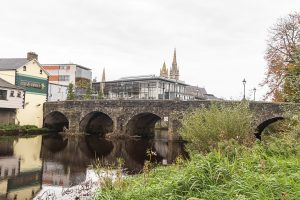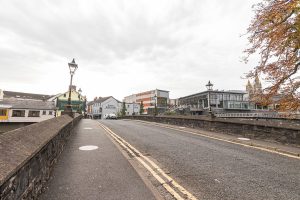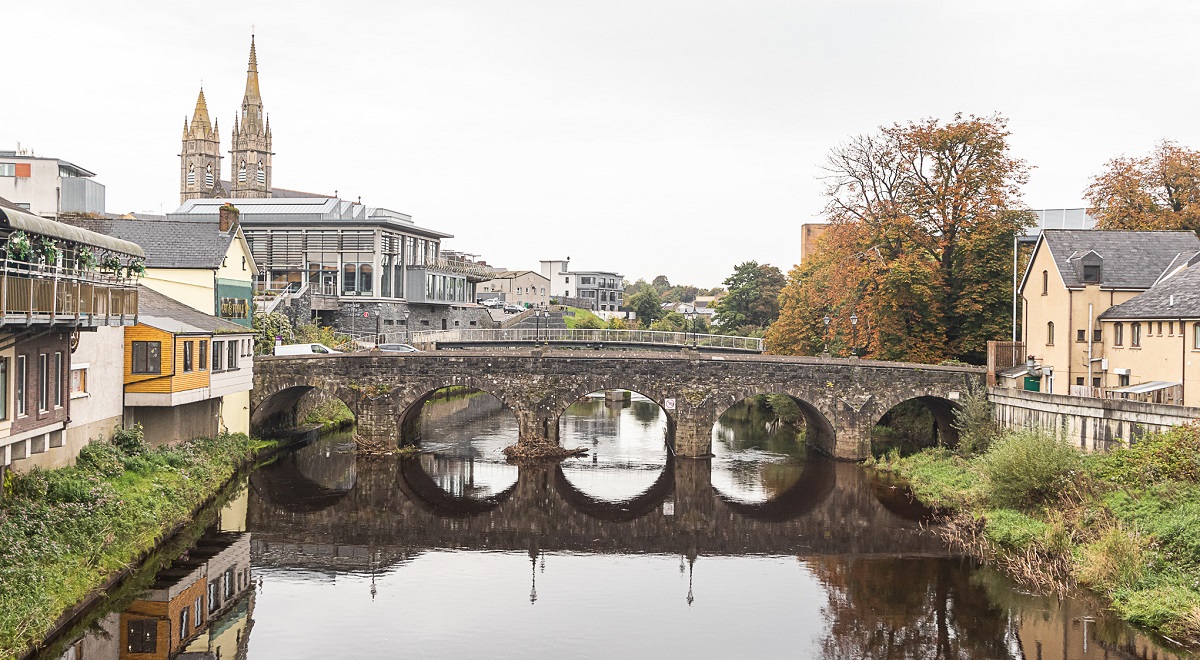Drunken feuds, acts of heroism, and an important moment of community solidarity – Bell’s Bridge in Omagh has seen a lot during its long history.
Hundreds of people cross it every day, from uniformed children dragging themselves to school, to shoppers carrying baggage to vehicles of all shapes and sizes commuting their way around the town.
Many of these modern travellers may not know that the bridge has been a busy crossing point for more than 400 years.
Omagh’s earliest map – from 1610 – shows a small crossing leading to what once was called ‘Bridge Lane’, an area now commonly known as Bridge Street.
Depicted amongst the farms and small settlements appears to be a small wooden structure allowing the settlers on the townside of Omagh to cross onto a bigger housing settlement around where Drumragh Avenue is today.
As the years, and methods of transport, advanced… so too did the structural design of the bridge.
Omagh was becomimg more populated and the increased use of horse and cart required a stronger bridge to withstand the heavier traffic.
A new solid stone bridge was completed in 1833, and, to date, this structure has stayed – mostly – the same.

Why is it called Bell’s Bridge?
Well, before the construction of the Strule Arts Centre, a bakery once stood directly opposite the Cat and Fiddle (formerly Strain’s Bar).
This bakery was owned by James Bell, a local man who just happened to own the last building before the crossing, awarding himself the name to the bridge.
Having christened Omagh’s most well-known bridge, Mr Bell emigrated to the United States towards the end of the 19th century.
The last renovation to the bridge would occur in 1919, when the road was widened to allow for increasing traffic, which, by now, included motorised transport.
Another development you can see below deck actually stopped the river for a short period of time.
It was decided that a weir (low-level dam) should be installed below the Bell’s Bridge to make the river look more pleasing, and also control the flow of water.
This project was undertaken as part of the Omagh Regeneration Plan in 2004, and it took more than a year for the horse shoe-like structure in the river bed to be installed.
Twelve months later, the bakery which birthed the name of the bridge was demolished ahead of the development of the Strule Arts Centre. In its place stands a decorative garden with a path to the arts centre.
Aside from watching Omagh town develop brick-by-brick, the bridge has also seen experienced some humorous, tragic and defining moments in the town’s history.
One notable instance took place on the Saturday after the Omagh bomb, in August 1998.
Thousands took to the streets in remembrance and solidarity, and Bell’s Bridge held throngs of people as they mourned.
As time passed, cracks in the bridge walls appeared.
During the ‘Big Freeze’ of 2010, there were concerns that bridge might collapse due to its age.
However, after a quick fix from the-then Department for the Environment, the bridge reopened, and normal service resumed.

The bridge was also the location of astonishing rescue in 1951.
Early one morning, a child was playing upstream at the confluence by Drumragh Avenue, when she accidentally fell in, and was swept away by the river.
As pedestrians watched helplessly, a mother shouted to her son at their home in Old Market Place.
In an act of fearless bravado, the 18-year-old boy raced to Bell’s Bridge, and, without hesitation, dived into the dangerous current and caught hold of the child.
His brave actions were even more impressive, given that the boy revealed afterwards to a UH reporter that he couldn’t swim!
In the deep of the night, the lights on the bridge have guided many a drunken and boisterous person home.
An act of tomfoolery occurred on the bridge in 1965, when a drunken individual shouted abuse at the wrong man.
It was late one March evening when the man stumbled out from a bar, and proceeded down High Street and onto Bridge Street, where he decided to exclaim foul names to a passer-by.
Unfortunately for the intoxicated blether, the anonymous – at least to him – person was an RUC constable.
For reasons unknown, the man then decided to throw his coins over the bridge.
The constable apprehended the man, who then hit back at the officer, kicking his ankles and ripping his coat.
He was eventually charged with disorderly behaviour.
So, this iconic bridge has been witness to many antics and developments in its long history, yet it has always fulfilled its original objective as a main crossing point over the Strule.







